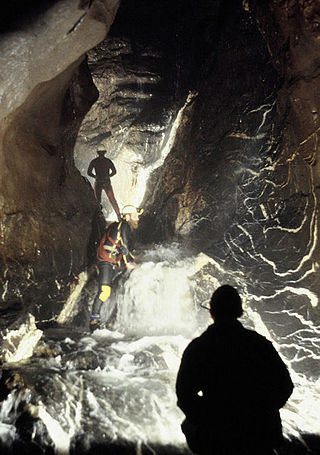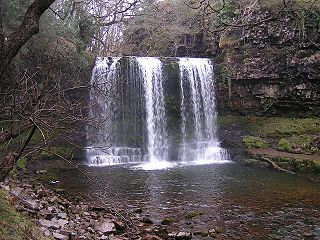
Ystradfellte is a village and community in Powys, Wales, about 6 miles (10 km) north of Hirwaun, with 556 inhabitants. It belongs to the historic county of Brecknockshire (Breconshire) and the Fforest Fawr area of the Brecon Beacons National Park, beside the Afon Mellte river. The village is linked by minor roads with Heol Senni to the north and the A4059 north of Penderyn, and with Pontneddfechan, which lies in the community, at the head of the Vale of Neath to the south.

The River Mellte is a river in south Wales. It is formed by the confluence of the Afon Llia and the Afon Dringarth. It then flows south through the village of Ystradfellte to Pontneddfechan where it joins with the Nedd Fechan to become the River Neath. The river derives its name from 'mellt' - the Welsh word for 'lightning' - after its tendency to rise and fall rapidly in response to heavy rainfall.

Ogof Ffynnon Ddu, also known informally as OFD, is a cave under a hillside in the area surrounding Penwyllt in the Upper Swansea Valley in South Wales. It is the second longest cave in Wales and the deepest in the United Kingdom.

Dan yr Ogof, at the National Showcaves Centre for Wales, is a 17-kilometre (11 mi) long cave system in south Wales, about 5 miles (8 km) north of Ystradgynlais and 15 miles (24 km) southwest of Brecon, in the Brecon Beacons National Park. It is the main feature of a show cave complex, which is claimed to be the largest in the UK and is a tourist attraction in Wales. The first section of the cave system is open to the public, but the extensive cave system beyond is scheduled as a national nature reserve and is open only to bona fide cavers.

Afon Hepste is a river in Powys, Wales, though partly forming the county's border with Rhondda Cynon Taf. It runs wholly within the Brecon Beacons National Park.

The River Alyn is a tributary of the River Dee in north-east Wales. It rises at the southern end of the Clwydian hills and the Alyn Valley forms part of the Clwydian Range and Dee Valley Area of Outstanding Natural Beauty. The main town on the river is Mold, the county town of Flintshire. It lends its name to the constitutencies of Alyn and Deeside in the UK Parliament and the Senedd.

Ogof y Daren Cilau is a cave system in the limestone escarpment on Mynydd Llangatwg, which is south of Llangattock village and above Crickhowell in south Powys, Wales. The escarpment is the remnant of quarrying that had begun by the mid-18th century and initially provided limestone for building and agriculture as a fertiliser, and subsequently for the blast furnaces of the local ironworks as a flux. The cave system was discovered in 1957 and is one of the longest in the United Kingdom. The system is next to the Ogof Agen Allwedd system.
The Afon Llia is a short river in Powys, Wales, and which is wholly contained within the Brecon Beacons National Park.
The Afon Dringarth is a river in Powys, Wales and wholly contained within the Brecon Beacons National Park. Its headwater streams drain the eastern slopes of Fan Dringarth, the southern slopes of Craig Cerrig-gleisiad and the western slopes of Fan Fawr. The river flows south-southwest for about 6 km / 3.5 mi to its confluence with the Afon Llia one mile north of the village of Ystradfellte, continuing south as the Afon Mellte. The river may derive its name from the hill immediately to its west, Fan Dringarth.

The River Giedd is a principal tributary of the River Tawe, Wales. The river runs within the county of Powys and lies almost wholly within the Brecon Beacons National Park.
Fforest Fawr Geopark is a Geopark in the Brecon Beacons National Park, south Wales. It is the first designated Geopark in Wales having gained membership of both the European Geoparks Network and the UNESCO-assisted Global Network of National Geoparks in October 2005. The Geopark aims to promote and support sustainable tourism and other opportunities to improve the economy of the area whilst safeguarding the natural environment. Its aims largely coincide with the statutory duties and purpose of the National Park within which it sits.

Mynydd Llangatwg or Llangattock Mountain is a hill in the Brecon Beacons National Park in the county of Powys, south Wales. It is named from the village of Llangatwg which sits in the valley of the River Usk to the north of it. It is essentially an undulating plateau rising in the west to a height of 530 metres (1,740 ft) at grid reference SO171157 and in the east to a height of 529 metres (1,736 ft) at Hen Dy-aderyn / Twr Pen-cyrn. This spot is marked by a trig point. The shallow pool of Pwll Gwy-rhoc sits in a broad depression towards the northern edge of the plateau whilst a smaller pool frequently occupies a large shakehole a few hundred metres to its west. The hill forms an impressive northern scarp overlooking the Usk valley and commonly referred to as the Llangattock Escarpment. Its southern margins are more subdued. Its eastern end is defined by the drops into the Clydach Gorge. Beyond the B4560 to the west the hill merges with Mynydd Llangynidr which has a similar character.

Garreg Las is a subsidiary summit of Fan Brycheiniog in the Brecon Beacons National Park in Carmarthenshire, southern Wales. Its summit sits towards the northern end of a broad north-south ridge, Esgair Hir, at 635 metres (2,083 ft) above sea level. The hill is sometimes referred to as Twyn Swnd.
Waterfall Country is a name often given to the upper reaches of the Vale of Neath in South Wales. The tourist area around the head of the valley has an unusually large number of publicly accessible waterfalls. The area is not officially defined but generally includes the group of falls on the Nedd Fechan, Pyrddin, Hepste and Mellte rivers, all of which lie between the villages of Pontneddfechan and Ystradfellte in the Brecon Beacons National Park.

Maen Llia is a standing stone which sits on moorland at grid reference SN924192 in the Brecon Beacons National Park in Powys, Wales.
Martyn Farr is a leading exploratory cave diver and caver, known for his record-breaking cave dives and the exploration of many miles of previously undiscovered underground passages. As an author and photographer he has written many books on the subject of cave diving history and techniques and caving locations.

Tawe-Uchaf is a community in Powys, Wales. Situated north-east of Ystradgynlais in the upper valley of the River Tawe, it includes the villages of Caehopkin, Coelbren, Glyntawe, Pen-y-cae, Penwyllt and Ynyswen. It had a population in 2001 of 1,516, increasing at the 2011 Census to 1,562.












